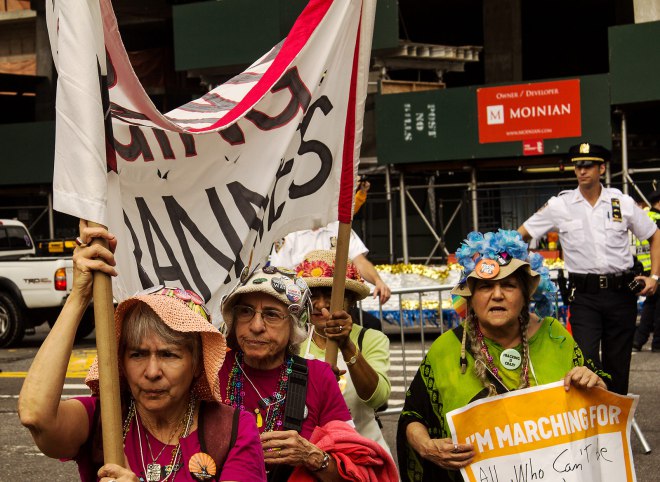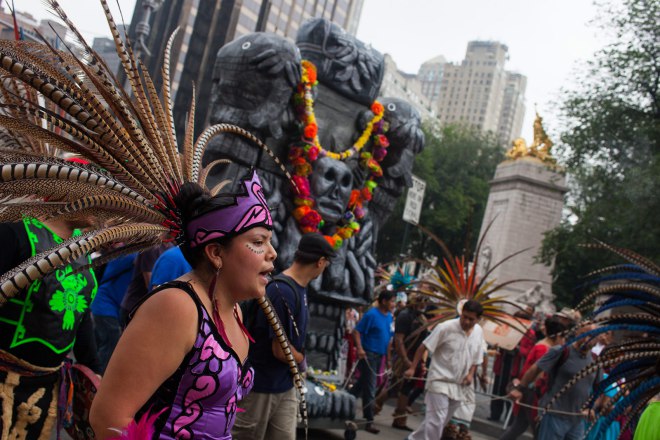Source: Grist
Damn, that was big! The People’s Climate March in New York City on Sunday brought out record crowds.
An official count conducted at the People’s Climate March in New York City showed that over 310,000 people participated in the largest climate rally in history — more than tripling pre-march estimates of 100,000. …
Shattering expectations, this official attendee count makes the People’s Climate March New York City’s largest social demonstration in the last decade. Well above the 50,000 who attended Forward on Climate in 2013 and the 80,000 who attended the 2009 march at the Copenhagen climate talks, the 310,000 attendees at today’s demonstration have set world history just days before a UN Summit bringing world leaders together to discuss tangible action on climate change. …
Relying on a crowd density analysis formula developed by a professor of game theory and complex systems at Carnegie Mellon University, the official attendee count calculates the average density of the march crowd over specific intervals, factoring in the surface area covered by the crowd and the speed and duration of the march.
Enterovirus D68 confirmed in Snohomish County
Dying Starfish Could Get Help From Congress

By Katie Campbell, KCTS9
WASHINGTON, D.C. — Researchers have been scrambling for more than a year to make sense of a strange disease that’s causing West Coast starfish to die by the millions.
Now it looks like help could be coming from Congress.
U.S. Rep. Denny Heck from Olympia introduced a bill Thursday that would dedicate federal funds for researching the epidemic, which has now spread along North America’s Pacific coast from Alaska to Mexico and in some places on the East Coast as well.
The disease has hit more than 20 species of West Coast starfish. Scientists are calling it the largest marine disease outbreak ever recorded.
Drew Harvell, a marine epidemiologist at Cornell University, has been studying the outbreaks in Puget Sound and is leading nationwide efforts to understand the epidemic. She says this legislation is critical because tracking marine disease outbreaks is so challenging.
“Disease outbreaks — they’re like lightning strikes. They occur unpredictably and rapidly,” Harvell says. “To identify their causative microorganisms or stop them from spreading requires significant scientific investigations on really short notice.”
- Watch: Underwater Video of Starfish Die-offs Hitting Washington’s Hood Canal
- Read: Rapidly Spreading Sea Star Disease Spurs Talk Of ‘Localized Extinction’ In Oregon
The proposed legislation would establish a plan for declaring and responding to the sea star disease outbreaks as well as future marine disease emergencies.
Harvell says increased funding could speed up the search for what’s causing the disease and for ways to prevent starfish from permanently vanishing from North American coastlines.
“It will allow scientists like me to leverage rapid funding and come up with proactive measures to protect our valuable marine fisheries and biodiversity,” Harvell says.
150 Native American Artists Converge on Tulsa for Cherokee Art Market
TULSA, Okla. – The ninth annual Cherokee Art Market will feature 150 inspirational and elite Native American artists from across the nation Oct. 11-12 from 10 a.m. to 5 p.m. in the Sequoyah Convention Center at Hard Rock Hotel & Casino Tulsa.
Admission is $5 per person.
The finest Native American artwork, representing more than 45 different tribes, will be displayed and sold at the Cherokee Art Market. Pieces include beadwork, pottery, painting, basketry, sculptures and textiles. Guests can also enjoy a variety of cultural and art demonstrations.
“Year in and year out, the Cherokee Art Market has proven to be one of the most prestigious Indian art shows in the country,” said Cherokee Nation Principal Chief Bill John Baker. “Every year our market continues to grow bigger and better. The Cherokee Art Market is a second-to-none showcase featuring world-class artisans in a variety of mediums.”
RELATED: Sculpture “Halfbreed” Wins Grand Prize at Cherokee Homecoming Art Show
As part of the two-day event, there will be public demonstrations from 11 a.m. to 4 p.m. each day. Demonstrations include jewelry stamp work technique, katsina doll making, pottery, painting and basket weaving.

An awards reception will be held in The Sky Room on Friday, Oct. 10, at 7 p.m. in honor of the Cherokee Art Market prizewinners, with $75,000 in overall prize money awarded across 22 categories. The public is welcome to attend the awards reception for $25 per person. Tickets will be available for purchase at the door.
The Cherokee Nation Foundation will also host its live art auction at the reception to raise funds for scholarships for Cherokee youth. Artists interested in donating should call the foundation at 918-207-0950.
“Best of Show” for the eighth annual Cherokee Art Market went to Alvin Marshall for his sculpture “A Little Girl’s Dream.”
For more information about the Cherokee Art Market, visit www.cherokeeartmarket.com.
Hard Rock Hotel & Casino Tulsa is located off Interstate 44 at exit 240. For more information, visit www.hardrockcasinotulsa.com or call (800) 760-6700.
Read more at http://indiancountrytodaymedianetwork.com/2014/09/17/150-native-american-artists-converge-tulsa-cherokee-art-market-156937
Are Fido’s Meds Polluting The Water?

Olivia Poblacion, OPB
Animal lovers are spending more on their pets than ever, and a lot of that money is going into vet care.
But medications the vet prescribes for Fido’s health may be contaminating our watersheds.
Just like pharmaceuticals and personal care products (PPCPs) for humans, soaps and medicines for pets contain compounds that can harm aquatic ecosystems.
“There is a cocktail of chemicals being detected in our watersheds,” said Sam Chan, a watershed health specialist with the Oregon Sea Grant.
Even though the concentrations are low, PPCPs in watersheds have still been shown to impact the development and behavior of fish and can make them more susceptible to predation.
The National Sea Grant program recently partnered with the American Veterinary Medicine Association to promote the reduction of improper PPCP disposal. As part of this project, Chan and other researchers at OSU are launching a national survey to learn more about the practices and awareness of this issue among pet owners and veterinary professionals.
“The main way people dispose of these products is by throwing them in the garbage,” Chan said. “It seems like a reasonable solution, but when they go to the landfill, rain seeps through and then the water is contaminated with those compounds.”
So what’s the best way to get rid of unused PPCP’s for pets? Definitely don’t flush them. Chan recommends either taking them to a drug take-back event or mixing them with something unpalatable to pets (such as coffee grounds) and then putting them in a sealed container and depositing in the trash.
Seattle City Council sets vote on changing Columbus Day to ‘Indigenous Peoples’ Day’
SEATTLE — The Seattle City Council will vote Oct. 6 whether to celebrate “Indigenous Peoples’ Day” on the same day as the Columbus Day holiday.
A council committee met Wednesday and advanced the resolution that would recognize the day on the second Monday in October in Seattle.
“We know Columbus Day is a federal holiday, we are not naive about that, but what we can do and what you have seen is a movement,” said Matt Remle, supporter of the Indigenous Peoples’ Day designation.
During the committee meeting, Italian Americans expressed their concerns. Many of them support Indigenous Peoples’ Day, but believe it should not replace Columbus Day.
“For most Italian Americans, Columbus Day is a symbol of pride in our heritage,” said Audrey Manzanares.
Many of those who spoke to the council committee did not attend the first hearing. In early September, the council delayed the decision.
As the council considers the change, Seattle Public Schools is in a similar situation.
District leaders were scheduled to discuss recognizing Indigenous Peoples’ Day at a board meeting Wednesday night.
“The city and a few other organizations have put it forward to us and requested our alignment in this work,” said Shauna Heath, of Seattle Public Schools.
Supporters of the measure expect the City Council to pass it.
“Hopefully, we will get a unanimous vote and honor native people, indigenous peoples, in this area,” said Remle.
Snohomish Zombie Walk, Sept 20
Visit Snohomish Zombie Walk on Facebook
We’re inviting all Zombies and ghouls to Downtown Snohomish for a friendly (or not!) visit. In preparation for the impending Zombie-Apocalypse, we’re asking all participants and spectators to bring “rations for the survivors”. (to benefit the Snohomish Food Bank)
Snohomish Zombie Walk
Saturday, Sept 20 at 5:30 PM
Zombies gather at the Carnegie Parking Lot – 110 Cedar Avenue, Snohomish at 5:00 for instructions and guidelines. Please park on the street.
Walk begins at 5:30 PM Lurch west on 1st Street to Avenue D, then U-turn back toward the east on 1st Street. Sidewalk only.
Food and Drink Specials for Zombies in Downtown Snohomish. (Participating restaurants and taverns to be announced on Tuesday, Sept 16)
Indian Country Grapples With Health Funding Shortfalls, Non-Payment
Slowly but surely, tribal governments — especially those in Alaska — are receiving millions of dollars in decades of unpaid contract costs from the Indian Health Service and Bureau of Indian Affairs.

WASHINGTON — Tribal health programs working to serve native people are not seeing funding of administrative costs keeping pace with need, and the Indian Health Service and the Bureau of Indian Affairs owe millions to tribal governments.
“The federal government has broken too many promises with tribes and though we have more work to do, I am pleased that we are seeing good progress with Alaska tribes receiving the money they are owed,” Alaska Sen. Mark Begich told the Alaska Native Tribal Health Consortium last month. “Failure to pay the full costs is unacceptable and I will continue to use my position on the Senate Indian Affairs Committee to keep up the pressure on the federal government.”
The IHS, a Department of Health and Human Services agency, provides health service systems for about 2.2 million of the nation’s estimated 3.4 million American Indians and Alaska Natives.
Funds allocated by the IHS, currently $4.4 billion per year, go toward administering medical care to tribes or are turned over to tribes for them to administer the care themselves. The IHS had been failing to provide full payments of contract costs until the Supreme Court ruled in June 2012 that the government must pay, determining that the tribes had been underpaid “between 77 percent and 92 percent of the tribes’ aggregate contract support costs” during previous decades.
Yet, according to Jacqueline Johnson Pata, executive director of the National Congress of American Indians, “payment has not happened.”
“The class action lawyers recently reported to NCAI on the lawyer’s discussions with the Justice Department. Although they couldn’t share much information, they did explain that there are close to 9,000 claim years at issue involving about 500 tribes and 19 years worth of contracts (1994-2013),” she told the U.S. Senate Committee of Indian Affairs last year.
Sen. Begich introduced Senate Bill 2669 in July to the Senate Appropriations Committee
to mandate funding for certain payments to Indian tribes and tribal organization. Additionally, the federal government has treaty and statutory obligations under the Indian Self-Determination and Education Assistance Act of 1975, which requires the government to contract with tribes to operate BIA and IHS programs. The agreement between the government and tribes is embedded in Article I, Section 8, of the U.S. Constitution.
At the end of 2013, less than 1 percent of thousands of claims in more than 200 lawsuits filed by tribes seeking a combined $200 billion had been settled — just 16 claims of an estimated 1,600.
Of the 566 nations the federal government recognizes, 229 are spread across the vast 572,000 square miles of Alaska, where they occupy small villages in remote areas — many only accessible by air or boat. For these tribes in remote areas, seeing a doctor might be inconvenient, to say the least, and almost definitely costly.
Lead counsel in the cases establishing government liability for IHS’s failure to pay, Lloyd Miller, an attorney based in Anchorage, Alaska, said IHS is severely underfunded.
“IHS is a prepared health plan paid for with a lot of blood and millions of acres of land,” Miller said. “Because the government took away their lands, there’s a responsibility.”
IHS gets $4.4 billion from Congress annually for what’s estimated to be a $15 billion need to meet the costs, he said.
Miller represents about 60 tribes, each with several claims filed for the costs owed.
In an August 2007 letter to the Senate Committee on Indian Affairs requesting an oversight hearing, Alaskan tribal health care providers reminded the committee that the Indian Self-Determination Act requires money to provide federal trust responsibilities.
“We write to once again call your attention to the grave crisis we face as a result of insufficient contract support cost appropriations which, together with Indian Health Service policies, have left our tribal organizations with annual shortfalls running from $2 million to over $8 million. We respectfully request that the Senate Indian Affairs Committee convene an urgent oversight hearing this Fall, to review what has become a genuine crisis in Indian country, and a crisis that has seriously eroded the national policy of Tribal self-governance and the delivery of quality health services to Alaska Native people,” the letter stated.
By August of this year, 12 of Alaska’s tribal health providers received $449 million to resolve contract support costs disputes with the IHS. Another 11 providers were still in negotiations. The Alaska Native Tribal Health Consortium, serving more than 143,000 native people, received the largest payment, with a $153 million settlement that includes $115.5 for past-due costs and $37.7 million in interest. At about $128 million, Southcentral Foundation received the next largest settlement.
The NCAI has been working with tribes and the IHS on contract costs since the Indian Self-Determination Act went into effect.
The congress is hosting the annual Tribal Unity Gathering and Legislative Impact Days on Sept. 16 and 17 in Washington. During the event, tribal leaders and representatives will meet with their delegates to the U.S. Congress to encourage action on important delegation before this session ends. IHS appropriations will be among the issues discussed.
“There’s strong support from the House and Senate,” said Amber Eberb, program manager of the NCAI Policy Research Center. “There’s quite a few champions who understand that tribes administering their own programs to respond to their community needs is more effective than a federal agency.”
There’s still progress to be made, Eberb said.
“Contract costs and other treaty issues should not be considered discretionary but mandatory,” Ebarb said. “All program money that uphold treaty agreements should be mandatory. It’s morally correct to do. Perhaps a little difficult to do right now.”
Disparities in well-being
American Indian and Alaska Native (AI/AN) death rates were nearly 50 percent greater than rates among non-Hispanic whites during 1999-2009, according to a study by the Centers for Disease Control.
The study was carried out by the CDC’s Division of Cancer Prevention and Control, the CDC’s National Center for Health Statistics, CDC researchers, the IHS, and partners from tribal groups, universities and state health departments.
It revealed:
Among AI/AN people, cancer is the leading cause of death, followed by heart disease, while the opposite is true for other races studied;
- Death rates from lung cancer have shown little improvement in AI/AN populations. AI/AN people have the highest prevalence of tobacco use of any population in the United States;
- Deaths from injuries were higher among AI/AN people compared to non-Hispanic whites;
- Suicide rates were nearly 50 percent higher for AI/AN people compared to non-Hispanic whites, and more frequent among AI/AN males and persons under age 25;
- Death rates from motor vehicle crashes, poisoning, and falls were two times higher among AI/AN people than for non-Hispanic whites;
- Death rates were higher among AI/AN infants compared to non-Hispanic white infants. Sudden infant death syndrome and unintentional injuries were also more common. AI/AN infants were four times more likely to die from pneumonia and influenza;
- By region, the highest mortality rates were in the Northern Plains and Southern Plains, while the East and Southwest had the lowest.
“Many of the observed excess deaths can be addressed through evidence-based public health interventions,” the report concluded.
In November 2013 testimony before the Senate Committee on Indian Affairs, Alaska Sen. Lisa Murkowski said:
“I listened very intently yesterday at the tribal summit when the President spoke. I went there specifically to hear what he was going to say on the issue of contract support costs. What I heard him say is, we have heard you loud and clear, but we are still working to find the answers. I don’t think we need to work to find any answers. I think that the court laid it out very, very clearly. It said that full reimbursement will be provided. So we have to make that happen within that budget. We have to make that priority.”
Murkowski said she had listened to the stories of the impact of lack of funds, saying, for example, that the regional health provider in Juneau had to close its alcohol treatment facility. Further north, in the Yukon Delta, the regional health provider laid off 20 employees, permanently closed 40 vacant positions, and reduced services for elders, she continued.
The impacts of the sequestration, she said, also meant that tribes would not be able to reduce waiting times at emergency rooms or outpatient and dental clinics.
“The impact, I think we recognize, has been significant,” she said.
Murkowski submitted comments she received from Alaska Natives around the state, including the Association of Village Council Presidents.
Proposed Increase for IHS Budget
“Tribes have not recovered from sequestration that resulted in across-the-board cuts to all federal programs that tribes are reliant upon. Nowhere was this more impactful than to the Indian Health Services, where due to sequestration, continuing resolutions, and the 16 day government shutdown — healthcare to Indian people was jeopardized,” U.S. Senate Committee on Indian Affairs Chairman Jon Tester, of Montana, said in March.
Tami Truette Jerue, tribal administrator and director of social services for the Anvik Tribal Council in Alaska addressed the committee’s oversight hearing in February. The Anvik are an Athabascan village of about 275 members on the west bank of the Yukon River.
Jerue represented the 37 federally recognized tribes that make up the Tanana Chiefs Conference, an inter-tribal health and social services consortium that serves an area of Interior Alaska that is roughly the size of Texas.
She delivered a message from more than 200 tribes across Alaska:
“It is absolutely essential that, without regard to technical land titles and the technical Indian country status of lands or tribal communities, our Tribes must have the tools necessary to combat drug and alcohol abuse, domestic violence, and violence against women. Fighting these scourges in our communities and healing our people cannot be made to stand on technicalities. We need to get to work, and now. And we need Congress’s help to do that. The State is not the problem, because the State is nowhere to be found in most of our Villages….
“Today, the tribes of Alaska come to you, not as victims of a failed governmental policy, but as powerful and responsible advocates for our people. We are stepping up to do what we must do. But without equally firm action from Congress, our people will suffer, we will continue with decades more of litigation battles and loopholes will continue to be found which deny our tribes the funding necessary to improve law and order in our communities.”
In the budget for the 2015 fiscal year, the Obama administration proposed a 4.5 percent increase for IHS, representing a $200 million increase over the current level to $4.6 billion.
The 2015 budget request includes:
- An additional $50 million to help obtain health care from the private sector through the Purchased/Referred Care program (formerly known as the Contract Health Services program). This program allows for the purchase of essential health care services that the IHS and tribes do not provide in their local facilities;
- An additional $71 million to support staffing and operating costs at four new and expanded facilities;
- An additional $30 million to fully fund the estimated amount of contract support costs for new and expanded contracts and compacts in fiscal year 2015. This will help tribes cover the cost of administrative functions for compacts or contracts established under the authority of the Indian Self-Determination and Education Assistance Act;
- An additional $31 million to address medical inflation costs;
- Additional funding to pay costs for new tribes and restoration of reductions in the fiscal year 2014 operating plan.
In his statement, Tester noted the “positive highlights” in the budget request.
“The Committee is pleased that the Administration finally understands its legal obligation to fully fund Contract Support Costs for the both the Indian Health Service and Bureau of Indian Affairs,” Tester said. “I am particularly encouraged by the $11 million increase for social services and job training to support an initiative to provide a comprehensive and integrated approach to address the problems of violence, poverty, and substance abuse.”
Covering IHS shortfalls with the Affordable Care Act
The Southeast Alaska Regional Health Consortium and more than 50 tribes wrote a letter to President Obama on Oct. 13.
In part, it said, “Among your administration’s most important achievements has been the development of historic settlements with Indian Tribes in several major litigations, its advocacy for amendments to the Indian Health Care Improvement Act and the Violence Against Women’s Act, and its commitment to critical appropriations measures. But when it comes to honoring the Nation’s commitment to the contracting and compacting Tribes who were historically, and illegally, underpaid, and who continue to be underpaid, the administration has permitted fiscal concerns to eclipse the imperative to do justice and to honor the nation’s obligations.”
In July the IHS reached a settlement with the consortium for claims during the years 1999 through 2013. The payment — $39.5 million plus interest — totals about $53 million.
“A lot of tribes had to close down programs because of lack of funds,” Andrea Thomas, outreach and enrollment manager of SEARHC, told MintPress News. “Part of what the settlement can do is bring back what was lost.”
Alaska did not create reservations like the 48 contiguous states, and many Native communities formed consortiums, like SEARHC, to use IHS funding for health care to serve them all.
SEARHC is a nonprofit tribal health consortium of 18 Native communities which serves the health interests of the Tlingit, Haida, Tsimshian, and other Native people of Southeast Alaska. In 1982, the consortium took over operations at the IHS clinic in Juneau, and then took over operations at Mt. Edgecumbe Hospital, formerly an IHS-run facility, in 1986.
“In Alaska we have the highest cost of health care in the nation,” Thomas said. “There’s vast wilderness surrounding each place. In order for me to get out of my community, I’d have to fly or take a ferry. This gets incredibly expensive.”
Many Alaskan villages have a community health clinic, but complicated procedures such as chemotherapy or serious surgeries, require patients to go to hospitals at regional hubs or to the Alaska Native Medical Center in Anchorage. The burden is on the tribal health consortium to pay the costs of a commercial jet, float plane, ferry, or boat.
If a medical evacuation helicopter is needed, it would cost SEARHC about $95,000 — a cost that could be absorbed by the Affordable Care Act.
“The issue is that IHS only provides about half the money for services,” Thomas said. “We rely on other revenues like grants and billing Medicare and Medicaid. If native people enroll, it puts more money back and we could offer more services or expanded services.”
Further, a member of a federally recognized tribe can get a lifetime exemption. Alaska Natives and American Indians are exempt from Affordable Care Act tax penalties because they receive care through the IHS. But through the new health care scheme, they are eligible for subsidies from private insurance. Thomas said that those who fall between 100 percent and 500 percent of the federal poverty level pay a monthly premium, but no deductibles or out-of-pocket expenses.
Yet, of more than 100,000 self-identified Alaskan Natives or American Indians, only 115 had signed up for health insurance through the Affordable Care Act as of April.
“Not a lot of people realize what the Affordable Care Act does for Alaskan Native people,” Thomas said.
Coverage also extends to Native people who are not enrolled members of a federally recognized tribe and meet federal guidelines. Thomas said they can receive a lifetime hardship exemption, rather than a tribal exemption, and there may be some out-of-pocket expense.
1st Annual Marysville Multicultural Fair – A celebration of diversity
Source: City of Marysville
The City of Marysville, Mayor’s Diversity Advisory Committee and Marysville Arts Coalition invite you to the 1st Annual Marysville Multicultural Fair set for 10 a.m.-3 p.m. on Saturday, Sept. 20 in downtown Comeford Park, 514 Delta Ave.
Come celebrate diversity in the Marysville-Tulalip communities and the many cultures who call the area home.
The multicultural fair is a free event for the entire family. Enjoy music and dance from around the world on stage in the Rotary Pavilion in Comeford Park. Experience traditions from other lands through demonstrations and displays. Enjoy the food court where exotic ethnic foods will be available for purchase, and explore artwork on display from our diversity arts contest coordinated by the Marysville Arts Coalition. Plenty of cultural resource and craft vendors, and hands-on activities for children.
The Coalition will announce and display the winning entries from an all-ages diversity arts contest earlier this year. The multicultural fair is proudly sponsored by key sponsor Sea Mar Community Health Centers, HomeStreet Bank, Marysville/North County YMCA, Molina Healthcare and Marysville Free Methodist Church.
Come one, come all “We are excited to offer this new event to bring hundreds of people together in a celebration of the many diverse nations, languages and cultures of the world through food, art, music and dance,” says Mayor Jon Nehring. Nehring established the Diversity Advisory Committee in 2010 to advise him and city government leaders on issues of diversity and inclusion. The Committee also includes representation from advocates of individuals with a physical or mental disability.
Music and dance with Mi Pais mariachi band, Bollywood-style dance featuring Rhythms of India, The Tarantellas with songs of Italy, Voices of the Village, Native American flautist Peter Ali, Marysville Y Break-Dancers and Mexican youth dance in traditional wear. Native American storytellers, cultural resource vendors, food court with ethnic specialties for purchase, and diversity artwork on display.
See www.marysvillewa.gov/multiculturalfair for more details.
Shellfish Tell Puget Sound’s Polluted Tale
By Ashley Ahearn, KUOW
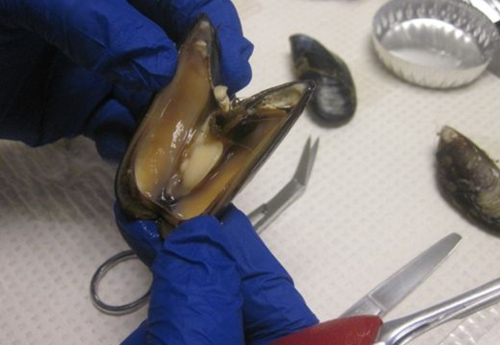
SEATTLE — Scientists used shellfish to conduct the broadest study to date of pollution levels along the shore of Puget Sound.
And in some places, it’s pretty contaminated.
This past winter the Washington Department of Fish and Wildlife put mussels at more than 100 sites up and down Puget Sound.
After a few months, volunteers and WDFW employees gathered the shellfish and analyzed them for metals, fossil fuel pollution, flame-retardants and other chemicals. The WDFW just released the results.
“The biggest concentrations of those contaminants were found in the highly urbanized bays – Elliott Bay, Salmon Bay, in the Sinclair Inlet, Commencement Bay we found much higher contaminations than we did in the rest of Puget Sound,” said Jennifer Lanksbury, a biologist who led the study for the Department of Fish and Wildlife.
PAHs – or polycyclic aromatic hydrocarbons – were found in mussels at every single test site. PAHs come from fossil fuels – spilled oil, wood stove smoke and engine exhaust, mainly. The particles can be deposited through the air or get washed into Puget Sound when it rains. Some PAHs are carcinogenic.
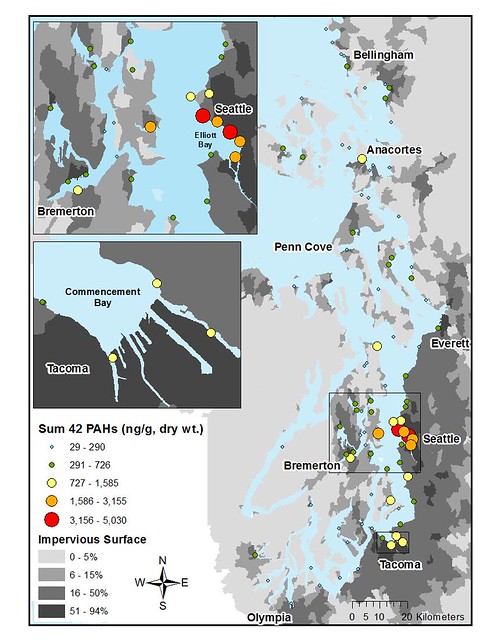
Map of PAH levels in Puget Sound. Credit: WDFW
The mussel samples all contained PCBs as well. Flame retardants and DDT were found at more than 90 percent of the sites – with the highest levels in more urban bays.
“This is showing that these contaminants are entering the nearshore food web and they’re likely being passed up to other higher organisms and people eat mussels too,” Lanksbury added.
The state Department of Health does rigorous testing for toxic algae and bacteria in shellfish – the kind of stuff that makes you sick immediately. But it doesn’t regularly test shellfish for metals and other contaminants that can harm human health over longer periods of exposure.
“PAH is a difficult issue,” said Dave McBride with the Department of Health. “They are widespread in the environment. We probably get a lot greater exposure to PAHs from the food we eat on the grill, hamburgers or smoked salmon. It’s all relative. Some of the PAHs are considered carcinogens so it’s definitely on our radar.”
Shellfish harvest, in general, is limited in dense urban areas – where the DFW’s mussel study showed the highest levels of contaminants. However, this past winter China banned all imports of shellfish from much of the west coast after finding elevated levels of arsenic in some shellfish harvested near Tacoma.
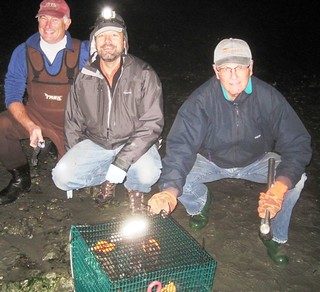
Volunteers Jonathan Frodge, Chris Wilke and Paul
Fredrickson gather mussel samples at Discovery
Park in Seattle. Credit: Tom Foley
Lanksbury says that she still feels safe eating mussels and other shellfish from Puget Sound. And, she adds, there are things people can do to lower pollution levels.
“When they say, don’t let your car drip oil, support low-impact development where they’re having rain gardens, don’t wash your car on the side of the road – all of those kinds of things spare Puget Sound from contaminants that we produce on a daily basis by burning fossil fuels,” Lanksbury said.
The Department of Fish and Wildlife hopes to keep the mussel monitoring program going, with the continued help of more than 100 volunteers and citizen scientists from around Puget Sound.



